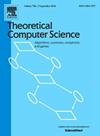Finding a minimum spanning tree with a small non-terminal set
IF 0.9
4区 计算机科学
Q3 COMPUTER SCIENCE, THEORY & METHODS
引用次数: 0
Abstract
In this paper, we study the problem of finding a minimum weight spanning tree that contains each vertex in a given subset of vertices as an internal vertex. This problem, called Minimum Weight Non-Terminal Spanning Tree, includes s-t Hamiltonian Path as a special case, and hence it is NP-hard. In this paper, we first observe that Non-Terminal Spanning Tree, the unweighted counterpart of Minimum Weight Non-Terminal Spanning Tree, is already NP-hard on some special graph classes. Moreover, it is W[1]-hard when parameterized by clique-width. In contrast, we give a 3k-vertex kernel and -time algorithm, where k is the size of non-terminal set . The latter algorithm can be extended to Minimum Weight Non-Terminal Spanning Tree with the restriction that each edge has a polynomially bounded integral weight. We also show that Minimum Weight Non-Terminal Spanning Tree is fixed-parameter tractable parameterized by the number of edges in the subgraph induced by the non-terminal set , extending the fixed-parameter tractability of Minimum Weight Non-Terminal Spanning Tree to a more general case. Finally, we give several results for structural parameterization.
求助全文
约1分钟内获得全文
求助全文
来源期刊

Theoretical Computer Science
工程技术-计算机:理论方法
CiteScore
2.60
自引率
18.20%
发文量
471
审稿时长
12.6 months
期刊介绍:
Theoretical Computer Science is mathematical and abstract in spirit, but it derives its motivation from practical and everyday computation. Its aim is to understand the nature of computation and, as a consequence of this understanding, provide more efficient methodologies. All papers introducing or studying mathematical, logic and formal concepts and methods are welcome, provided that their motivation is clearly drawn from the field of computing.
 求助内容:
求助内容: 应助结果提醒方式:
应助结果提醒方式:


